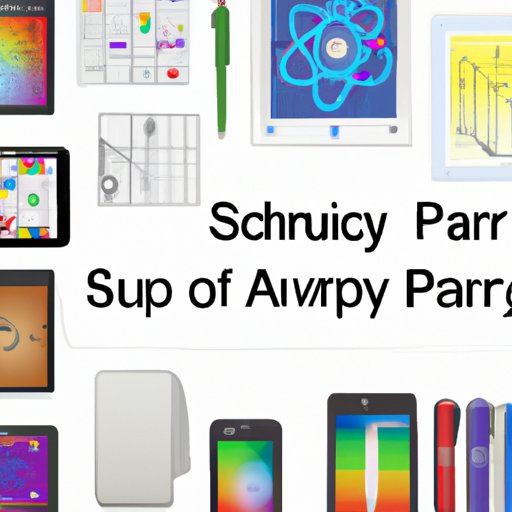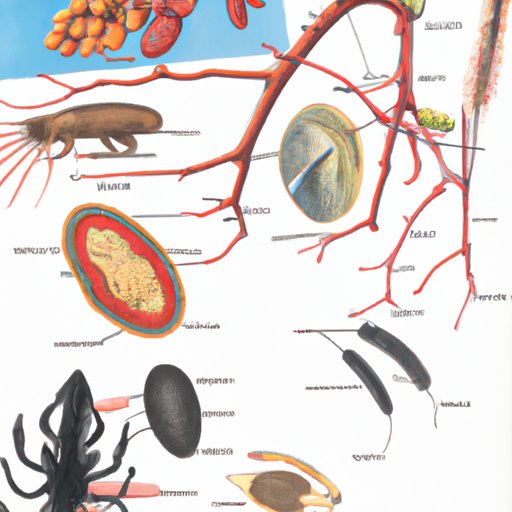Introduction
Drawing science stuff is an important skill for scientists, engineers, and other professionals who need to communicate visuals of their work. While drawing may not be the first thing that comes to mind when you think of scientific research, it can be an invaluable tool for visualizing data, illustrating experiments, and making complex concepts easier to understand. This article will provide a step-by-step tutorial on how to draw science stuff, as well as advice on choosing the right materials and tools, using software and apps, interviewing a professional scientific illustrator, and exploring examples of artwork created by scientific illustrators.
Step-by-Step Tutorial for Drawing Scientific Diagrams
Drawing scientific diagrams can seem daunting at first, but with a few basic steps and some practice, anyone can learn to create accurate, visually appealing illustrations. Here are the basics steps to follow when drawing scientific diagrams:
- Choose your subject: Start by deciding what you want to draw and gathering any reference material you will need, such as photographs or diagrams.
- Sketch out your ideas: Use light pencil lines to sketch out the basic shapes and outlines of your diagram. This will allow you to adjust elements without having to start over if something doesn’t look right.
- Add details: Once you have the basic outline in place, start adding details like labels, measurements, arrows, and other elements that will help convey your message.
- Clean up your lines: Use a ruler and eraser to clean up your lines and make sure everything is neat and precise.
- Color your diagram: Add color to your diagram to make it more visually appealing. You can use colored pencils, markers, or even crayons for this step.
When drawing scientific diagrams, it is important to keep accuracy in mind. According to a study published in the International Journal of Science Education, “accurate drawings can serve as powerful tools for understanding and communicating science concepts.” Therefore, it is important to take the time to ensure that all labels, measurements, and other elements are correct and clearly legible.
Tips for Creating Realistic Illustrations
Once you have mastered the basics of drawing scientific diagrams, you can begin to explore more advanced techniques to create realistic illustrations. Here are a few tips to help you get started:
- Use shading to add depth and texture to your illustrations.
- Experiment with different mediums and tools to create unique effects.
- Include details like textures and patterns to make your illustrations more lifelike.
- Pay attention to perspective and scale to create more realistic images.
- Incorporate elements of nature into your illustrations to make them more engaging.
By following these tips, you can create realistic illustrations that are both visually appealing and scientifically accurate. According to a study published in the journal Science Communication, “realistic illustrations can help viewers better understand complex scientific concepts.” Therefore, taking the time to create realistic illustrations can be an invaluable tool for communicating scientific knowledge.

Choosing the Right Materials and Tools
The right materials and tools can make all the difference when it comes to drawing scientific diagrams. Here is an overview of the materials and tools you will need:
- Paper: Choose high-quality paper that is thick enough to hold up to repeated erasing and reworking.
- Pencils: Use a range of pencils with different lead strengths to achieve different effects.
- Rulers: Use rulers to draw straight lines and measure distances accurately.
- Erasers: Keep a variety of erasers on hand to erase mistakes quickly and easily.
- Colored pencils/markers/crayons: These materials can be used to add color to your illustrations.
When choosing materials and tools, it is important to consider your budget and skill level. If you are just starting out, it is best to start with basic materials and tools that are affordable and easy to use. As you gain more experience, you can gradually upgrade to more expensive, higher-quality materials and tools.

Software and Apps for Drawing Science Stuff
In addition to traditional materials and tools, there are a variety of software and apps available that can make drawing science stuff easier and more efficient. Here is an overview of some of the most popular software and apps:
- Adobe Illustrator: Adobe Illustrator is a powerful vector graphics editor that can be used to create sophisticated illustrations.
- Autodesk Sketchbook: Autodesk Sketchbook is a digital drawing and painting app designed for artists of all skill levels.
- CorelDRAW Graphics Suite: CorelDRAW Graphics Suite is an extensive collection of graphic design tools that can be used to create professional-looking illustrations.
- Inkscape: Inkscape is a free and open-source vector graphics editor that can be used to create detailed scientific diagrams.
- Pixelmator: Pixelmator is a powerful image editor that can be used to create realistic illustrations.
These software and apps can be used to create intricate illustrations quickly and efficiently. By taking advantage of the various features and tools available, you can create high-quality scientific diagrams with ease.
Interview with a Professional Scientific Illustrator
To get a better understanding of the process of drawing science stuff, we spoke with professional scientific illustrator Michelle White. Here are some of the questions we asked her:
- What inspired you to become a scientific illustrator?
- What advice do you have for someone just starting out in the field?
- What are some of the challenges you face when creating illustrations?
- What tips do you have for creating realistic illustrations?
- What software and apps do you use most often when creating illustrations?
White shared some valuable insights with us, including the importance of accuracy, the need to experiment with different materials and tools, and the value of software and apps for creating realistic illustrations. She also emphasized the importance of taking the time to learn the fundamentals before jumping into more complicated projects.

Examples of Artwork Created by Scientific Illustrators
To get a better idea of what is possible with scientific illustration, here are some examples of artwork created by professional scientific illustrators:
- A 3D rendering of a molecule: Scientists use 3D renderings of molecules to study their structure and behavior.
- A diagram of a cell: Cell diagrams are used to visualize the structure and components of a cell.
- An illustration of a plant: Plant illustrations are used to identify species and study the anatomy of plants.
- A diagram of an animal: Animal diagrams are used to study the anatomy of animals and compare different species.
- A map of a planet: Planetary maps are used to study the geography and geology of planets and moons.
These examples show the incredible range of possibilities that scientific illustration offers. By taking the time to master the fundamentals of drawing science stuff, you can create beautiful, accurate illustrations that can be used to communicate complex scientific concepts.
Conclusion
Drawing science stuff can be a daunting task, but with the right materials, tools, and techniques, anyone can learn to create accurate, visually appealing illustrations. This article provided a step-by-step tutorial on how to draw science stuff, as well as tips for creating realistic illustrations, advice on choosing the right materials and tools, and an overview of software and apps. We also interviewed a professional scientific illustrator and explored examples of artwork created by scientific illustrators. By following the advice in this article, you can learn to create beautiful, scientifically accurate illustrations that can be used to communicate complex concepts.
(Note: Is this article not meeting your expectations? Do you have knowledge or insights to share? Unlock new opportunities and expand your reach by joining our authors team. Click Registration to join us and share your expertise with our readers.)
